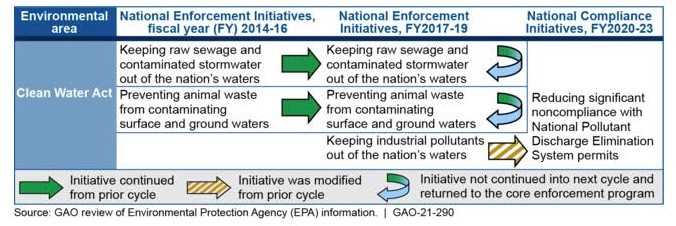Clean Water Act – NPDES Compliance and Enforcement- What is U.S. EPA’s Focus?
Posted: August 26th, 2021
Authors: Karen T.
The United States Government Accountability Office (GAO) published a Report Clean Water Act – EPA Needs to Better Assess and Disclose Quality of Compliance and Enforcement Data in July 2021. The GAO found that since 2015, the United States Environmental Protection Agency (U.S. EPA) has modified its national initiative emphasizing compliance with the Clean Water Act (CWA). The goal of the modified initiative is to reduce significant noncompliance with National Pollutant Discharge Elimination System (NPDES) permits by half by the end of fiscal year 2022. The GAO reviewed U.S. EPA’s enforcement of the CWA related to (1) changes since 2015 in U.S. EPA’s national initiatives for ensuring compliance with the act, (2) changes in NPDES compliance and enforcement activities since 2015, and (3) the extent to which U.S EPA is measuring progress toward compliance with the NPDES program[1].
The GAO recommends that the Assistant Administrator of U.S. EPA’s Office of Enforcement and Compliance Assurance implement the following:
- Revise its guidance to select files for its State Review Framework assessments of state-reported data to incorporate statistically valid probability sampling.
- Ensure that consolidated, complete, and updated information on all data limitations is disclosed on the State Water Dashboard.
- Develop a plan to determine the overall accuracy and completeness of the permit limit and discharge monitoring report data recorded in its national database.
- Develop a performance measure to track the reduction in pollutant discharges resulting from enforcement actions for facilities in significant noncompliance and disclose any limitations.
GAO’s Fast Facts for this report states:
“The EPA uses National Pollutant Discharge Elimination System (NPDES) permits to regulate wastewater discharges. However, nearly 11,000 facilities significantly exceeded their permit limits and illegally discharged pollutants into nearby waters in 2018. EPA has a goal to reduce by half significant noncompliance with individual NPDES permits by the end of FY 2022. But the data that states and facilities report to EPA to help track compliance is incomplete and has errors. We recommended (among other things) assessing the quality of the NPDES data that states and facilities are reporting so EPA can be sure it’s making progress toward its goal.”
What does this mean for facilities with NPDES permits?
This may seem like meaningless paperwork and accounting, but it can also affect your compliance status and bottom line. Part of the concern from GAO is that the databases and data collected from individual states are incomplete or have significant errors, and as such, the GAO is asking for quality assurance reviews of the information in the system. U.S EPA will be asking state agencies to not only report more reliable data, but also provide it in a timely manner.
One Important data set includes your discharge monitoring data, reported on Discharge Monitoring Reports (DMRs) and uploaded to a central database. As a facility, be proactive and review your DMRs carefully. Make sure the permit limits, outfalls, and other pertinent information is accurate and complete. If it isn’t, reach out to your State agency to have that updated. Also make sure data entered by your facility representatives are complete and accurate. Watch for units of measurement to make sure you don’t enter an erroneous data point. Errors, regardless of origin, will be your noncompliance liability and possibly result in enforcement.
A second concern from GAO is that the significant noncompliance issues identified at facilities during inspections and record reviews are not being fully, accurately, timely and consistently reported to U.S. EPA. The reporting of significant noncompliance differs based on an individual state’s interpretation of what it considers reportable. U.S. EPA has conducted federally led compliance audits to ascertain if an individual state is finding and recording significant noncompliance issues. Keeping in mind an inspection from your state agency with no significant noncompliance may not be the same outcome if U.S. EPA regional inspectors are conducting the inspection, so be proactive. Pull out your NPDES individual or general permit and review it. Think about more frequent or more comprehensive inspections.
Here are a few items to keep in mind for compliance:
- Are you sampling at correct frequencies?
- Do you have the required Stormwater Pollution Prevent Plan (SWPPP) or Best Management Practices (BMP) and are they up to date?
- Are you using the correct EPA methodology to analyze for your listed parameters?
- Does your lab meet the correct detection limits?
- If you are showing exceedances, what corrective action are you taking and is it fully documented?
- What equipment or technology should be upgraded or replaced? Are you planning for capital expenditures?
Be ready for more frequent and in-depth visits from your state agency or U.S. EPA and reduce the risk of significant noncompliance issues at your facility. ALL4 provides water quality compliance services with experienced professionals. If you have specific wastewater needs, contact one of our water practitioners, Paul Hagerty, Meghan Skemp, William Shane, Bruce Armbruster or Lizzie Smith.


